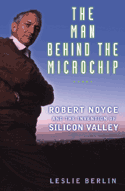
By Leslie Berlin
Oxford University Press,
June 2005
416 pages, $30
“Before Intel and Google, before Microsoft and dot-coms . . . and stock-option millionaires . . . and billionaire venture capitalists, there was a group of eight young men—six of them with Ph.D.s, none of them over 30—who disliked their boss and decided to start their own transistor company.” The result: Fairchild Semiconductor.
So begins the biography of one of those eight men, Robert Noyce, who 11 years later would help create Intel. Along the way, this son of an Iowa minister became one of the inventors of the integrated circuit—the device at the heart of personal computers, cell phones, video games and just about every other modern device you can name.
In the telling, by Leslie Berlin, a visiting scholar at Stanford University, Noyce comes off, as you would expect, as brilliant. He majored in math and physics at Grinnell College, because those courses came to him most easily. Indeed, he won a student-given “award” for the “senior man who earned the best grades with the least amount of work.” MIT, where Noyce earned his Ph.D., proved to be only slightly more challenging.
After completing his studies, Noyce worked in R&D at Philco, which led to his being recruited by the legendary—and mercurial—William Shockley, the tyrannical boss Berlin mentions in the book’s introduction.
Over the course of the biography, we learn not only about the process that led to the integrated circuit—Noyce wasn’t trying to create a revolutionary invention, he was attempting to solve a production problem—but also about Noyce’s lifelong obsession with aviation, and how the concept of venture capital is far from new. The $500 Noyce chipped in to start Fairchild Semiconductor was worth $300,000 two years later, when the firm was acquired.
The book is thoroughly researched: There are some 60 pages of single-spaced notes, along with a 14-page bibliography. But Berlin’s tone is accessible, not academic. And if she occasionally repeats a fact—that the first President Bush called the widow upon Noyce’s death, for instance—or includes one to show off, she can be forgiven.
Ironically, Berlin’s detailed chronicling of Noyce’s success—in a posthumous tribute the San Jose Mercury News described Noyce as a combination of Henry Ford and Thomas Edison—leaves you with the impression that he could have accomplished much more. As Berlin points out, although Noyce never won a Nobel Prize, he could have shared in two that were awarded to others. Noyce died ten years before his coinventor, Jack Kilby, won for the integrated circuit in 2000; and he had done unpublished work on the tunnel diode, a key concept in quantum physics for which the Nobel Prize was awarded in 1973.
But Noyce was not very good at following through on the various insights he had. So why should we care about him? His story is an indispensable snapshot that shows us just how far we have come—and how much further there is to go. n
Paul B. Brown is the author of numerous business books, including The Rules, which will be published by Doubleday this fall.



